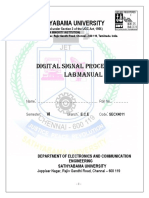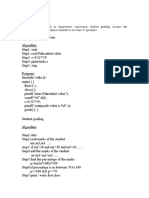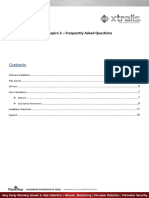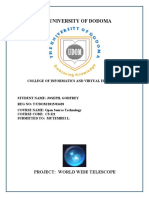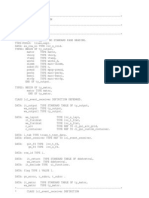Matlab Script File
Uploaded by
tvr123Matlab Script File
Uploaded by
tvr123% Matlab script file: homework7.m % This file is provided as part of Homework 7 for course EE583.
% % Depending on the variable 'algorithm', this file performs % 'LMS' least-mean square (LMS) algorithm % 'RLMS' recursive LMS algorithm % 'FXLMS' filtered-X LMS algorithm % 'FULMS' filtered-U LMS algorithm (to be added) % 'FX_ONL' filtered-X LMS algorithm with online sys id (to be added). % Signals and transfer paths are generated by this script file. For % simulations, type eg. % >> algorithm = 'LMS'; % >> homework7; % System and algorithm parameters have to be set in this file. See below. % % Notation and variables % N_x number quantities (taps, iterations,...) % lower case signals and constants % upper case tap-delay lines and filter coefficients; % tap-delay lines are organized in time-reversed % order ! % Recommended parameter settings % % LMS N_a=40; mu=0.01; % RLMS N_a=5; N_b=35; mu=0.01; % FXLMS N_a=40; mu=0.01; % FULMS N_a=15; N_b=25; mu=0.005; % FX_ONL N_a=40; mu=0.005; mu_c=0.1; var(z) = 0.05; % % Questions % please feel free to contact: % Stephan Weiss EEB 426, Tel. (213) 740 4676 % email : saweiss@sipi.usc.edu
% ***** parameters ***** N_i = 2000; % number of iterations N_a = 40; % number of forward coeff. in main adapt. filter N_b = 35; % number of feedback coeff. " N_c = 5; % taps in error path N = max([N_a N_b N_c])+1; % important for synchronization of signals mu = 0.01; % step size for main adaptive filter mu_c= 0.1; % step size for online system identification
% ***** create "perfect" (ie. no feedback) noise reference ***** x = randn(N_i,1);
% ***** create implicitly primary path h and desired signal d(n)***** rho = 0.85; theta = 0.25*pi; gain = 0.25; % set characteristics d = gain*filter(1,[1 -2*rho*cos(theta) rho^2],x);
%***** create error path C and initialize the estimate C_hat ***** C = [zeros(1,N_c-1) 1]'; % error path impulse response: delay if strcmp(algorithm,'FX_ONL'), C_hat = zeros(size(N_c)); % online system identification else C_hat = C; % perfect error path model end;
% ***** adaptive noise cancellation ***** A = zeros(N_a,1); % initialize adaptive filter coeffs to zero B = zeros(N_b,1); clear y e1 e2 e3 x_hat; % to allow the tap delay lines to be filled with zeros, we start with % an index if strcmp(algorithm,'LMS'), % ***** LMS Algorithm ***** for n = 1:N_i-N, % [B.Widrow] X_a = x(n+N-1:-1:n+N-N_a); % built tap-delay line of filter y = X_a'*A; % calculate filter output e1(n+N-1) = d(n+N-1)-y; % calculate error A = A + (2*mu*e1(n+N-1))*X_a; % LMS weight update end; elseif strcmp(algorithm,'RLMS'), % ***** Recursive LMS **** y = zeros(N_i,1); % [P.Feintuch] for n = 1:N_i-N, X_a = x(n+N-1:-1:n+N-N_a); % built tap-delay line of filter A Y_b = y(n+N-2:-1:n+N-N_b-1); % built tap-delay line of filter B y(n+N-1) = X_a'*A + Y_b'*B; % calculate filter output
e1(n+N-1) = d(n+N-1)-y(n+N-1); % calculate error A = A + (2*mu*e1(n+N-1))*X_a; % LMS weight update filter A B = B + (2*mu*e1(n+N-1))*Y_b; % LMS weight update filter B end; elseif strcmp(algorithm,'FXLMS'), % ***** filtered-X LMS ***** for n = 1:N_i-N, % [B.Widrow] X_a = x(n+N-1:-1:n+N-N_a); % update tap-delay line of filter
y = X_a'*A; % calculate filter output e1(n+N-1) = d(n+N-1)+y; % calculate superposition E1 = e1(n+N-1:-1:n+N-N_c)'; % built tap-delay line e2(n+N-1) = E1'*C; % filter error signal by error path % e2 is the error visible to the % algorithm X_c = x(n+N-1:-1:n+N-N_c); % built tap-delay line delay to x_hat(n+N-1) = X_c'*C_hat; % filter signal by error path model % x_hat is the "filtered-X" signal X_hat = x_hat(n+N-1:-1:n+N-N_a)';% tap delay line for algorithm A = A - (2*mu*e2(n+N-1))*X_hat; % filtered-X LMS weight update end; elseif strcmp(algorithm,'FULMS'), % ***** filtered-U LMS ***** % [Erikkson] % ***** please add your owm omplementation ***** % ***** of the filtered-U LMS algorithm here ***** N_a = 15; N_b = 25; N = max([N_a N_b N_c])+1; mu = 0.005; A = zeros(N_a,1); B = zeros(N_b,1); y = zeros(N_i,1); for n = 1:N_i-N, X_a = x(n+N-1:-1:n+N-N_a); Y_b = y(n+N-2:-1:n+N-N_b-1); y(n+N-1) = X_a'*A + Y_b'*B; e1(n+N-1) = d(n+N-1)+y(n+N-1); E1 = e1(n+N-1:-1:n+N-N_c)'; % built tap-delay line e2(n+N-1) = E1'*C_hat; % filter error signal by error path % e2 is the error visible to the % algorithm X_c = x(n+N-1:-1:n+N-N_c); % built tap-delay line delay to x_hat(n+N-1) = X_c'*C_hat; % filter signal by error path model % x_hat is the "filtered-X" signal X_hat = x_hat(n+N-1:-1:n+N-N_a)';% tap delay line for algorithm Y_c = y(n+N-2:-1:n+N-N_c-1); y_hat(n+N-2) = Y_c'*C_hat;
Y_hat = y_hat(n+N-2:-1:n+N-N_b-1)'; A = A - (2*mu*e2(n+N-1))*X_hat; B = B - (2*mu*e2(n+N-1))*Y_hat; end;
elseif strcmp(algorithm,'FX_ONL'), % ***** filtered-X with online % system identification ***** % [Eriksson] % ***** please add your owm omplementation ***** % ***** of the filtered-X LMS algorithm with ***** % ***** online system identification *****
else error('algorithm type unknown'); end; % ***** Display **** % calculate optimum filter impulse response (truncated) dirac = [1.0 zeros(1,N-2)]'; h = gain*filter(1,[1 -2*rho*cos(theta) rho.^2],dirac); % % the optimum weight will be shown as red stars, while % the true adapted filter weight appear as yellow stem plots. % clg; if strcmp(algorithm,'LMS'), subplot(211); e1 = e1(N:N_i-1);
plot(10*log10(e1.^2)); title('mean squared error - LMS'); ylabel('MSE / [dB]'); xlabel('iterations'); subplot(212); stem(A); hold on; plot(h,'r*'); title('filter coefficients'); ylabel('coeff. value'); xlabel('taps'); print -dps lms; end; if strcmp(algorithm,'RLMS'), subplot(211); plot(10*log10(e1.^2)); title('mean squared error - RLMS'); ylabel('MSE / [dB]'); xlabel('iterations'); subplot(212); dirac = [1.0 zeros(1,N-2)]'; w = filter(A,[1 -B'],dirac); plot(h,'r*'); hold on; stem(w); title('filter coefficients'); ylabel('coeff. value'); xlabel('taps'); print -dps rlms; end; if strcmp(algorithm,'FXLMS'); subplot(211); plot(10*log10(e1.^2)); title('mean squared error - FXLMS'); ylabel('MSE / [dB]'); xlabel('iterations'); subplot(212) stem(A); hold on; plot(-h,'r*'); title('filter coefficients'); ylabel('coeff. value'); xlabel('taps'); print -dps fxlms;
end; if strcmp(algorithm,'FULMS'); subplot(211); plot(10*log10(e1.^2)); title('mean squared error - FULMS'); ylabel('MSE / [dB]'); xlabel('iterations'); subplot(212) dirac = [1.0 zeros(1,N-2)]'; w = filter(A,[1 -B'],dirac); plot(-h,'r*'); hold on; stem(w); title('filter coefficients'); ylabel('coeff. value'); xlabel('taps'); print -dps fulms; end;
Here is the LMS and RLS matlab codes..... LMS xLen = 2000; %sequence length hLen = 10; %filter length sigma_w2=0.0; %AWGN power D=0; delta=0.06; c = [1; 0.8]; %channel impulse response x = rand_sym(sqrt(2), xLen+200, 1); %x=real(x); d = [zeros(D,1); x]; %take delay into consideration y = conv(x,c); %y(1:D)=[]; %take delay into consideration w=sqrt(sigma_w2)/2*(randn(length(y),1)+j*randn(length(y),1)); y=y+w; ryy=y(101Len+100)'*y(101Len+100)/xLen h=zeros(hLen,1); h(D+1)=1; for ii=101Len+100 xhat(ii)=h.'*y(ii:-1:ii-hLen+1); e(ii)=d(ii)-xhat(ii); h=h+delta*e(ii)*conj(y(ii:-1:ii-hLen+1)); end hopt=h eq=conv(c,hopt) figure(1) stem(abs(eq)) figure(2) plot(10*log10(abs(e).^2)) figure(3) plot((abs(e).^2)) RLS xLen = 2000; %sequence length hLen = 10; %filter length sigma_w2=0.0; %AWGN power D=0; weight=1; c = [1; 0.8]; %channel impulse response x = rand_sym(sqrt(2), xLen+200, 1); %x=real(x); d = [zeros(D,1); x]; %take delay into consideration y = conv(x,c); %y(1:D)=[]; %take delay into consideration w=sqrt(sigma_w2)/2*(randn(length(y),1)+j*randn(length(y),1)); y=y+w; ryy=y(101Len+100)'*y(101Len+100)/xLen h=zeros(hLen,1); h(D+1)=1; Rinv=eye(hLen); for ii=101Len+100 yvec=y(ii:-1:ii-hLen+1); xhat(ii)=h.'*yvec; e(ii)=d(ii)-xhat(ii); K=Rinv*conj(yvec)/(weight+yvec.'*Rinv*conj(yvec)); Rinv=(Rinv-K*yvec.'*Rinv)/weight; h=h+K*e(ii);
end hopt=h eq=conv(c,hopt) figure(1) stem(abs(eq)) figure(2) plot(10*log10(abs(e).^2)) figure(3) plot((abs(e).^2))
You might also like
- Loma 301 Chapter 1 Overview of Insurance Administration100% (1)Loma 301 Chapter 1 Overview of Insurance Administration12 pages
- Scilab Code For Implementing LMS Algorithm (Function) For P 2No ratings yetScilab Code For Implementing LMS Algorithm (Function) For P 27 pages
- Ipendant Customization Manual Ver.7.70 (MAROC77CG01101E Rev.100% (1)Ipendant Customization Manual Ver.7.70 (MAROC77CG01101E Rev.222 pages
- Commvault Complete Data Protection Customer PresentationNo ratings yetCommvault Complete Data Protection Customer Presentation33 pages
- % % Program Name - Prob8261a.m (Modified Problem 8.26 (1), p553) % Comparison of Characteristic Features of Discrete-Time Butterworth, % Chebyshev 1, Chebyshev 2 and Elliptic Lowpass FiltersNo ratings yet% % Program Name - Prob8261a.m (Modified Problem 8.26 (1), p553) % Comparison of Characteristic Features of Discrete-Time Butterworth, % Chebyshev 1, Chebyshev 2 and Elliptic Lowpass Filters10 pages
- %covolution of Two Sequences & %comparison With Conv CommandNo ratings yet%covolution of Two Sequences & %comparison With Conv Command21 pages
- Design of Adaptive Equalizer: Using LMS AlgorithmNo ratings yetDesign of Adaptive Equalizer: Using LMS Algorithm8 pages
- Matlab Code: LMS Adaptive Noise CancellationNo ratings yetMatlab Code: LMS Adaptive Noise Cancellation3 pages
- Digital Communication Systems Lab Software: Meghna Rattanpal 17BEC0580No ratings yetDigital Communication Systems Lab Software: Meghna Rattanpal 17BEC058019 pages
- Program: 1: 'BX' On 'G.' 'K ' 'Received Signal' 'Equalized Signal' 'Signal Constellation' 'Iteration #' ' (' ') ' OffNo ratings yetProgram: 1: 'BX' On 'G.' 'K ' 'Received Signal' 'Equalized Signal' 'Signal Constellation' 'Iteration #' ' (' ') ' Off4 pages
- Assignment No 1: Submitted To: Sir. Dr. Tair Zaidi.No ratings yetAssignment No 1: Submitted To: Sir. Dr. Tair Zaidi.5 pages
- Solution Manual For Communication Systems Haykin 6No ratings yetSolution Manual For Communication Systems Haykin 650 pages
- Cognitive Radio System: 1. Square-Root Raised Cosinefilter User Define FunctionNo ratings yetCognitive Radio System: 1. Square-Root Raised Cosinefilter User Define Function8 pages
- X 1:10 ( (X 1) && (X 4) ) y (X) 2 (X 5) y (X) 4 y (X) 0 : OutputNo ratings yetX 1:10 ( (X 1) && (X 4) ) y (X) 2 (X 5) y (X) 4 y (X) 0 : Output7 pages
- Generation of Elementary Discrete Time Sequence With Formula Generation of Elementary Discrete Time Sequence Without FormulaNo ratings yetGeneration of Elementary Discrete Time Sequence With Formula Generation of Elementary Discrete Time Sequence Without Formula11 pages
- Nonlinear Control Feedback Linearization Sliding Mode ControlFrom EverandNonlinear Control Feedback Linearization Sliding Mode ControlNo ratings yet
- From President's Desk : Information & Communication Technologies (ICT) in Condition Monitoring!!No ratings yetFrom President's Desk : Information & Communication Technologies (ICT) in Condition Monitoring!!4 pages
- Board of Intermediate Education: Senior Inter PhysicsNo ratings yetBoard of Intermediate Education: Senior Inter Physics2 pages
- No 1 Website For Andhra University StudentsNo ratings yetNo 1 Website For Andhra University Students2 pages
- No 1 Website For Andhra University StudentsNo ratings yetNo 1 Website For Andhra University Students4 pages
- In Service Monitoring of Turbine Blades: It Is Time For Indian Railway To Take On CBM..No ratings yetIn Service Monitoring of Turbine Blades: It Is Time For Indian Railway To Take On CBM..4 pages
- Multithreading Interview Questions: Click HereNo ratings yetMultithreading Interview Questions: Click Here37 pages
- GLS - GSS613 Spatial Data Analyses and ModellingNo ratings yetGLS - GSS613 Spatial Data Analyses and Modelling112 pages
- Navigation and Path Following Guidance of A Small Auv - Maya: From Concept To PracticeNo ratings yetNavigation and Path Following Guidance of A Small Auv - Maya: From Concept To Practice7 pages
- Collaborative Networks: Integrating Blockchain For Enhanced Trust and TransparencyNo ratings yetCollaborative Networks: Integrating Blockchain For Enhanced Trust and Transparency9 pages
- The University of Dodoma: Project: World Wide TelescopeNo ratings yetThe University of Dodoma: Project: World Wide Telescope6 pages
- Dharmendra Kumar Dubey: Academic ProfileNo ratings yetDharmendra Kumar Dubey: Academic Profile3 pages
- Loma 301 Chapter 1 Overview of Insurance AdministrationLoma 301 Chapter 1 Overview of Insurance Administration
- Scilab Code For Implementing LMS Algorithm (Function) For P 2Scilab Code For Implementing LMS Algorithm (Function) For P 2
- Ipendant Customization Manual Ver.7.70 (MAROC77CG01101E Rev.Ipendant Customization Manual Ver.7.70 (MAROC77CG01101E Rev.
- Commvault Complete Data Protection Customer PresentationCommvault Complete Data Protection Customer Presentation
- % % Program Name - Prob8261a.m (Modified Problem 8.26 (1), p553) % Comparison of Characteristic Features of Discrete-Time Butterworth, % Chebyshev 1, Chebyshev 2 and Elliptic Lowpass Filters% % Program Name - Prob8261a.m (Modified Problem 8.26 (1), p553) % Comparison of Characteristic Features of Discrete-Time Butterworth, % Chebyshev 1, Chebyshev 2 and Elliptic Lowpass Filters
- %covolution of Two Sequences & %comparison With Conv Command%covolution of Two Sequences & %comparison With Conv Command
- Digital Communication Systems Lab Software: Meghna Rattanpal 17BEC0580Digital Communication Systems Lab Software: Meghna Rattanpal 17BEC0580
- Program: 1: 'BX' On 'G.' 'K ' 'Received Signal' 'Equalized Signal' 'Signal Constellation' 'Iteration #' ' (' ') ' OffProgram: 1: 'BX' On 'G.' 'K ' 'Received Signal' 'Equalized Signal' 'Signal Constellation' 'Iteration #' ' (' ') ' Off
- Assignment No 1: Submitted To: Sir. Dr. Tair Zaidi.Assignment No 1: Submitted To: Sir. Dr. Tair Zaidi.
- Solution Manual For Communication Systems Haykin 6Solution Manual For Communication Systems Haykin 6
- Cognitive Radio System: 1. Square-Root Raised Cosinefilter User Define FunctionCognitive Radio System: 1. Square-Root Raised Cosinefilter User Define Function
- X 1:10 ( (X 1) && (X 4) ) y (X) 2 (X 5) y (X) 4 y (X) 0 : OutputX 1:10 ( (X 1) && (X 4) ) y (X) 2 (X 5) y (X) 4 y (X) 0 : Output
- Generation of Elementary Discrete Time Sequence With Formula Generation of Elementary Discrete Time Sequence Without FormulaGeneration of Elementary Discrete Time Sequence With Formula Generation of Elementary Discrete Time Sequence Without Formula
- Nonlinear Control Feedback Linearization Sliding Mode ControlFrom EverandNonlinear Control Feedback Linearization Sliding Mode Control
- Worked Examples in Mechanical Vibrations using MATLABFrom EverandWorked Examples in Mechanical Vibrations using MATLAB
- From President's Desk : Information & Communication Technologies (ICT) in Condition Monitoring!!From President's Desk : Information & Communication Technologies (ICT) in Condition Monitoring!!
- Board of Intermediate Education: Senior Inter PhysicsBoard of Intermediate Education: Senior Inter Physics
- In Service Monitoring of Turbine Blades: It Is Time For Indian Railway To Take On CBM..In Service Monitoring of Turbine Blades: It Is Time For Indian Railway To Take On CBM..
- Navigation and Path Following Guidance of A Small Auv - Maya: From Concept To PracticeNavigation and Path Following Guidance of A Small Auv - Maya: From Concept To Practice
- Collaborative Networks: Integrating Blockchain For Enhanced Trust and TransparencyCollaborative Networks: Integrating Blockchain For Enhanced Trust and Transparency
- The University of Dodoma: Project: World Wide TelescopeThe University of Dodoma: Project: World Wide Telescope
























































